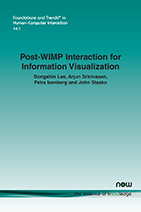Post-WIMP Interaction for Information Visualization
By Bongshin Lee, Microsoft Research, USA, bongshin@microsoft.com | Arjun Srinivasan, Georgia Institute of Technology, USA, arjun010@gatech.edu | Petra Isenberg, Inria, France, petra.isenberg@inria.fr | John Stasko, Georgia Institute of Technology, USA, stasko@cc.gatech.edu
Abstract
Well-designed interactions for visualization systems hold great promise both for empowering people to effectively complete their tasks and for providing more natural and engaging user experiences. Leveraging advancements in hardware and software technology, the visualization research community has made considerable progress providing novel input and interaction experiences. These technologies continue to advance at a fast pace, and thus it seems timely to look back at what has been achieved so far and contemplate what might be possible in the future. In this monograph, we first present a condensed summary of research efforts investigating post-WIMP interaction techniques in visualization systems. We also include research from the broader HCI community and several product releases from industry that we believe to be relevant and have influenced visualization interfaces. Furthermore, we reflect on our own projects that investigated post-WIMP InfoVis interaction and systems. We discuss the main challenges we faced and lessons we learned, and we reflect on how our perspectives and viewpoints on post-WIMP for InfoVis have evolved over the course of these projects. Finally, we identify several open research directions that will help realize the full potential of post-WIMP interaction for and with InfoVis, expanding the boundaries of InfoVis and reaching a broader audience.
Post-WIMP Interaction for Information Visualization
Interaction, a means for people to express their goals and intentions to systems, plays a critical role in information visualization (InfoVis). The importance of interaction grows as the size and complexity of data increases. Well-designed interactions empower people to effectively complete tasks with visualized data and can provide a more fluid and engaging experience. Both industry and the broad human-computer interaction (HCI) research community have made significant advancements in hardware and software technologies that can be leveraged to support novel interaction techniques. Well-designed interactions for visualization systems hold great promise both for empowering people to effectively complete their tasks and for providing more natural and engaging user experiences. With the advancements in hardware and software technology, the visualization research community has made considerable progress on providing novel input and interaction experiences and continues to advance at a fast pace. Thus, it seems timely to look back at what has been achieved so far and contemplate what might be possible in the future.
In this monograph, the authors first present a condensed summary of research efforts investigating post-WIMP interaction techniques in visualization systems. They include research from the broader HCI community and several product releases from industry that have influenced visualization interfaces. Furthermore, they reflect on their own projects that investigated post-WIMP InfoVis interaction and systems. The authors discuss the main challenges faced, lessons learned, and reflect on how their perspectives and viewpoints on post-WIMP for InfoVis have evolved over the course of these projects. Finally, they identify several open research directions that will help realize the full potential of post-WIMP interaction for and with InfoVis; expanding the boundaries of InfoVis and reaching a broader audience.
